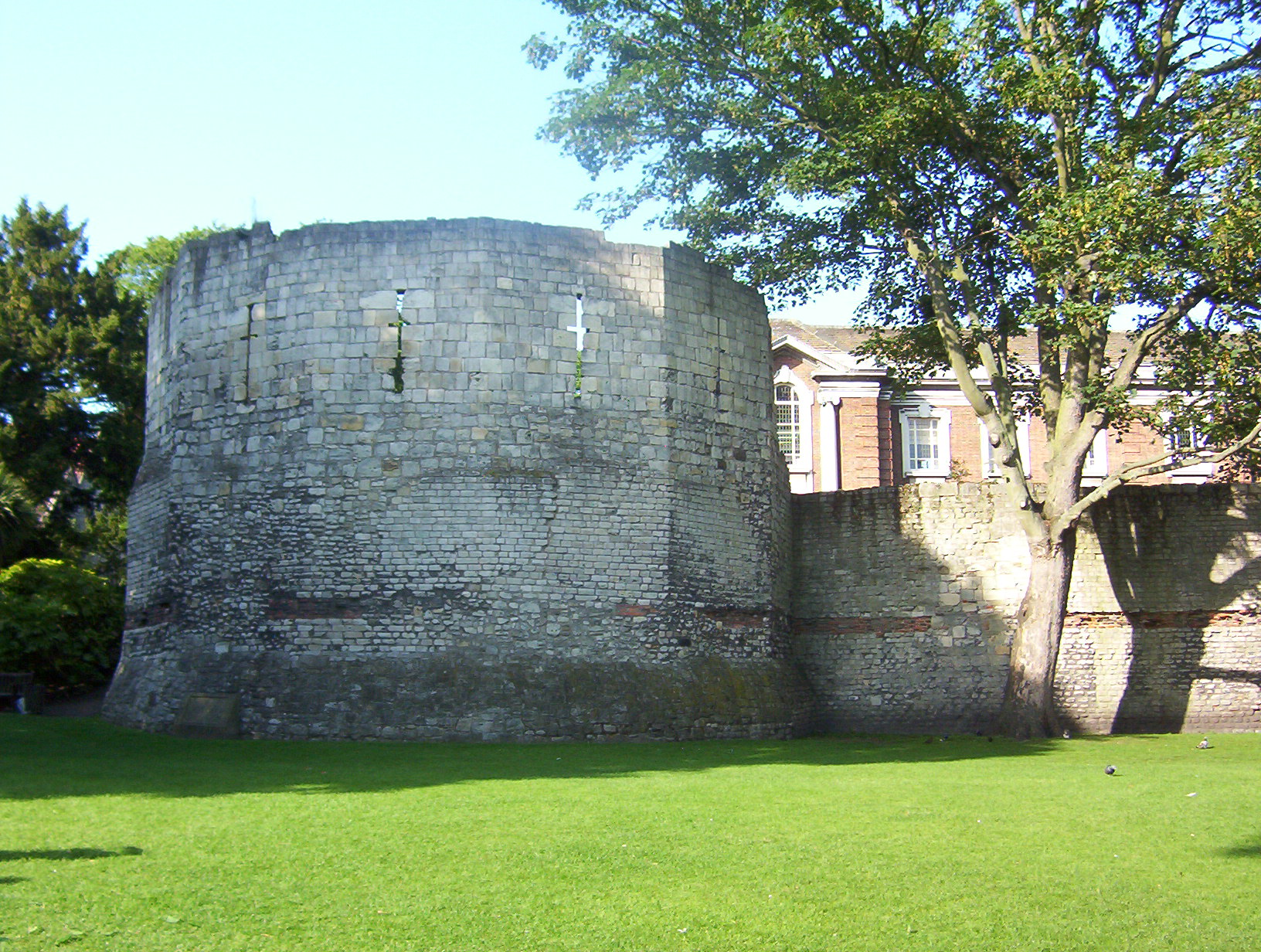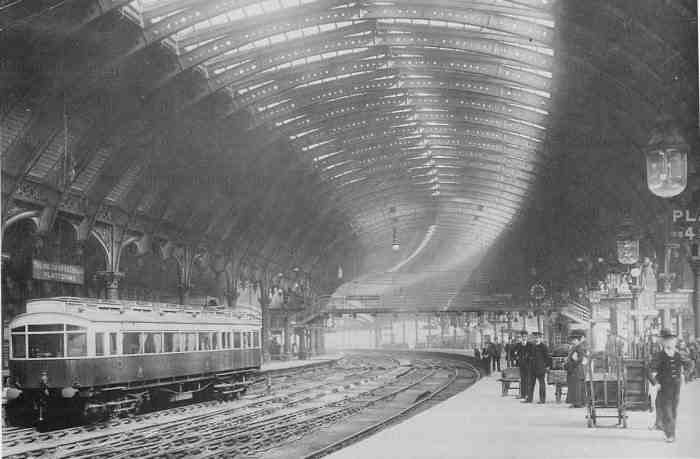|
Station Road (York)
Station Road is a street in the city centre of York, in England. History The street lies immediately outside York city walls, leading to the south bank of the River Ouse, Yorkshire, River Ouse. The area is likely to have seen some Roman and Anglian settlement, but later became partly a cemetery, with fields further out. In 1832, the city's cholera burial ground was established by the road. The street originated as part of Thief Lane, but following the construction of the new York railway station in 1877, the street was re-rerouted, and its southern part became Station Road. Layout and architecture The street runs north-east as a continuation of Queen Street, forming part of the city's inner ring road. At a crossroads with Station Rise and Station Avenue, it briefly turns south-east, under York city walls, then at another junction with Station Rise it turns north-east again. It terminates at a junction with Station Avenue, Rougier Street and Tanner's Moat, while its contin ... [...More Info...] [...Related Items...] OR: [Wikipedia] [Google] [Baidu] |
York
York is a cathedral city with Roman Britain, Roman origins, sited at the confluence of the rivers River Ouse, Yorkshire, Ouse and River Foss, Foss in North Yorkshire, England. It is the historic county town of Yorkshire. The city has many historic buildings and other structures, such as a York Minster, minster, York Castle, castle, and York city walls, city walls. It is the largest settlement and the administrative centre of the wider City of York district. The city was founded under the name of Eboracum in 71 AD. It then became the capital of the Roman province of Britannia Inferior, and later of the kingdoms of Deira, Northumbria, and Jórvík, Scandinavian York. In the Middle Ages, it became the Province of York, northern England ecclesiastical province's centre, and grew as a wool-trading centre. In the 19th century, it became a major railway network hub and confectionery manufacturing centre. During the Second World War, part of the Baedeker Blitz bombed the city; it ... [...More Info...] [...Related Items...] OR: [Wikipedia] [Google] [Baidu] |
Lendal Bridge
There are nine bridges across the River Ouse within the city of York, England, and sixteen smaller bridges and passages across the narrower River Foss. Bridges over the Ouse The earliest bridge, built by the Romans, linked Stonegate (the ''via praetoria'' of the Roman fortress) and Micklegate, and crossed the river approximately where the Guildhall now is. Its replacement, Ouse Bridge, was a wooden bridge built about downstream by the Vikings. It has been rebuilt three times, most recently between 1810 and 1820. The Scarborough Railway Bridge of 1845 was the second bridge to be built, and it was followed by two more road bridges, Lendal Bridge in 1863 and Skeldergate Bridge in 1882. The Millennium Bridge, a footbridge, was added in 2001. There are also Clifton Bridge in the northern suburbs of the city, two modern fly-overs carrying the outer ring road, and the former railway bridge at Naburn, which is now part of the York-Selby cycle path. North to south, the bridges are: ... [...More Info...] [...Related Items...] OR: [Wikipedia] [Google] [Baidu] |
York City Walls
York has, since Roman times, been defended by walls of one form or another. To this day, substantial portions of the walls remain, and York has more miles of intact wall than any other city in England. They are known variously as York City Walls, the Bar Walls and the Roman walls (though this last is a misnomer as very little of the extant stonework is of Roman origin, and the course of the wall has been substantially altered since Roman times). The walls are generally 13 feet (4m) high and 6 feet (1.8m) wide. History Roman walls The original walls were built around 71 AD, when the Romans erected a fort ( castra) occupying about 50 acres or 21.5 hectares near the banks of the River Ouse. The rectangle of walls was built as part of the fort's defences. The foundations and the line of about half of these Roman walls form part of the existing walls, as follows: *a section (the west corner, including the Multangular Tower) in the Museum Gardens *the north-west and nort ... [...More Info...] [...Related Items...] OR: [Wikipedia] [Google] [Baidu] |
River Ouse, Yorkshire
The River Ouse ( ) is a river in North Yorkshire, England. Hydrologically, the river is a continuation of the River Ure, and the combined length of the River Ure and River Ouse makes it, at , the sixth-longest river of the United Kingdom and (including the Ure) the longest to flow entirely in one county. The length of the Ouse alone is about but the total length of the river is disputed. It is a matter of opinion as to whether the River Ouse is formed at the confluence of the River Ure and the much-smaller Ouse Gill Beck at Cuddy Shaw Reach near Linton-on-Ouse, about six miles downstream of the confluence of the River Swale with the River Ure. An alternative opinion is recorded in a publication published in ''The Yorkshire Post'' in a series dated 1891, written and illustrated by Tom Bradley. His description and bird's-eye-view maps—specifically in his account of the River Swale—suggests that the River Ouse starts at the confluence of the Swale and the Ure. His narra ... [...More Info...] [...Related Items...] OR: [Wikipedia] [Google] [Baidu] |
York Railway Station
York railway station is on the East Coast Main Line serving the city of York, North Yorkshire, England. It is north of and on the main line it is situated between to the south and to the north. , the station is operated by London North Eastern Railway. York station is a key junction approximately halfway between London and Edinburgh. It is approximately north of the point where the Cross Country and TransPennine Express routes via Leeds join the main line, connecting Scotland and the North East, North West, Midlands and southern England. The junction was historically a major site for rolling stock manufacture, maintenance and repair. In ''Britain's 100 Best Railway Stations'' by Simon Jenkins, the station was one of only ten to be awarded five stars. History The first York railway station was a temporary wooden building on Queen Street outside the walls of the city, opened in 1839 by the York and North Midland Railway. It was succeeded in 1841, inside the walls, b ... [...More Info...] [...Related Items...] OR: [Wikipedia] [Google] [Baidu] |
Walking Part Of The City Walls, York - Geograph
Walking (also known as ambulation) is one of the main gaits of terrestrial locomotion among legged animals. Walking is typically slower than running and other gaits. Walking is defined by an 'inverted pendulum' gait in which the body vaults over the stiff limb or limbs with each step. This applies regardless of the usable number of limbs—even arthropods, with six, eight, or more limbs, walk. Difference from running The word ''walk'' is descended from the Old English ''wealcan'' "to roll". In humans and other bipeds, walking is generally distinguished from running in that only one foot at a time leaves contact with the ground and there is a period of double-support. In contrast, running begins when both feet are off the ground with each step. This distinction has the status of a formal requirement in competitive walking events. For quadrupedal species, there are numerous gaits which may be termed walking or running, and distinctions based upon the presence or absence of ... [...More Info...] [...Related Items...] OR: [Wikipedia] [Google] [Baidu] |
The Principal York
The Principal York is an historic Grade II listed building on Station Road, adjacent to York railway station, England. It is a five-storey building of yellow Scarborough brick and was completed in 1878, a year after the present station opened. The 1853 Hotel The first York station hotel (The York Royal Station Hotel) was opened on 22 February 1853, the architect was G. T. Andrews, as an addition to York old railway station. The hotel became redundant after the opening of the new station in June 1877 and was converted into offices. The 1878 Hotel The new hotel opened on 20 May 1878 as the Royal Station Hotel, York. The architect was William Peachey of the North Eastern Railway. The hotel was designed as an integral part of the new station and the North Eastern Railway Company's flagship hotel, and as such was managed directly by the railway company. It featured elegant, high-ceilinged banqueting rooms and 100 large bedrooms costing 14 shillings a night. It was built by ... [...More Info...] [...Related Items...] OR: [Wikipedia] [Google] [Baidu] |
George Leeman
George Leeman (August 1809 – 25 February 1882) was a lawyer, railwayman and a Liberal Member of Parliament (MP) for the City of York in the nineteenth century. Work Legal practice Leeman was articled to Robert Henry Anderson's legal practice, and established a legal practice in York in 1835 when he qualified as a solicitor. He became a senior partner in Leeman & Wilkinson of York and Beverley. He was Clerk of the Peace for the East Riding of Yorkshire from 1845 (and a member of the Society of Clerks of the Peace from November 1849) and a Deputy Lieutenant for the North Riding. Railwayman In 1849 he became chairman of the York, Newcastle and Berwick Railway, succeeding his rival the 'Railway King' George Hudson after Leeman's investigations helped uncover Hudson's illegal share dealing. Leeman was deputy chairman of the successor company, the North Eastern Railway, from 1855 to 1874 and chairman from 1874 to 1880, having encouraged its formation through mergers in 1 ... [...More Info...] [...Related Items...] OR: [Wikipedia] [Google] [Baidu] |
North Eastern Railway War Memorial
The North Eastern Railway War Memorial is a First World War memorial in York in northern England. It was designed by Sir Edwin Lutyens to commemorate employees of the North Eastern Railway (NER) who left to fight in the First World War and were killed while serving. The NER board voted in early 1920 to allocate £20,000 for a memorial and commissioned Lutyens. The committee for the York City War Memorial followed suit and also appointed Lutyens, but both schemes became embroiled in controversy. Concerns were raised from within the community about the effect of the NER memorial on the city walls and its impact on the proposed scheme for the city's war memorial, given that the two memorials were planned to be apart and the city's budget was a tenth of the NER's. The controversy was resolved after Lutyens modified his plans for the NER memorial to move it away from the walls and the city opted for a revised scheme on land just outside the walls; coincidentally the land was owned ... [...More Info...] [...Related Items...] OR: [Wikipedia] [Google] [Baidu] |
Grand Hotel And Spa (York)
The Grand, formerly the Grand Hotel and Spa, is a Grade II* listed hotel in York, England, the city's only 5-star hotel. Opened in May 2010 and renovated and extended in 2017–18, it is an Edwardian building dating to 1906, originally the headquarters of the North Eastern Railway, with views of the York city walls and York Minster. It is owned by Splendid Hospitality Group. History The Grand's building opened in 1906 as the headquarters of the North Eastern Railway (then one of the richest businesses in Britain); The NER's architect William Bell produced the basic structural design and commissioned architect Horace Field Horace Field was a London-born architect. His work was often in a Wrenaissance style, as well as other post-gothic English historical revival styles, with influences from the Arts and Crafts movement and Richard Norman Shaw. His commissions incl ... worked on the external and internal design. It is believed their design won a silver medal at an exhibition ... [...More Info...] [...Related Items...] OR: [Wikipedia] [Google] [Baidu] |





.jpg)
